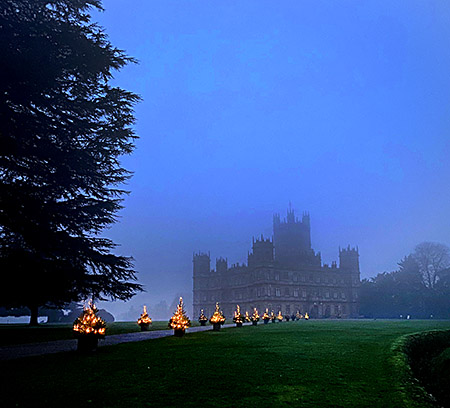
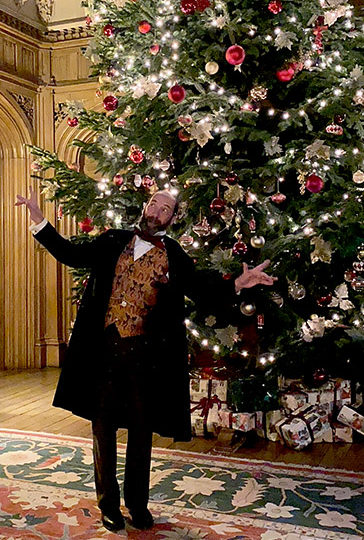
Gerald Dickens
“A Christmas Carol”, Stave 1:
“Marley was dead: to begin with. There is no doubt whatever about that. The register of his burial was signed by the clergyman, the clerk, the undertaker, and the chief mourner. Scrooge signed it;”.
Since it was first published 177 years ago, “A Christmas Carol” has sold over two million copies. Like me, many of you will have read Charles Dickens at school with more, or possibly less, enthusiasm although later on, I have been re-reading some of his books with much pleasure.
In some ways, I think they are best read out loud, perhaps as an audio book. Dickens was himself an actor and his stories are a performance, written for magazines in serial form. The colour and immediacy of his language brings characters and situations alive like no other author. He was also, by our standards, a campaigner, using words and stories to ask us to think about and change some of our behaviours and prejudices.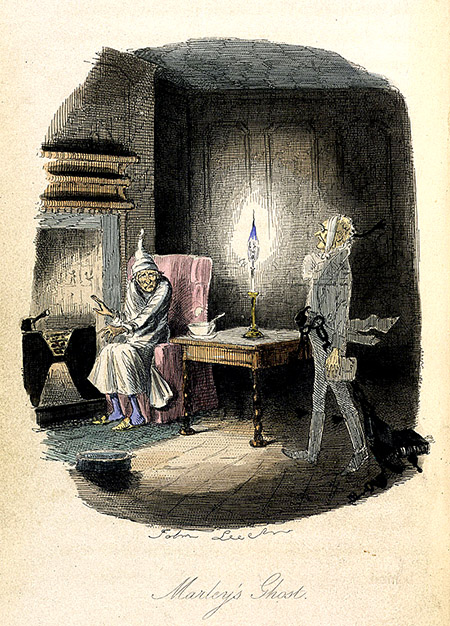
“A Christmas Carol” is written in five staves and three parts or should I say in three ghosts. The first spirit to visit the central character, Scrooge, is the “Ghost of Christmas Past”. This ghost is described in great detail and spends a fair amount of time with Scrooge, who to begin with is not at all engaged with this idea. In fact, he does his best to ignore the memories which the ghost insists on showing him and the form the Ghost takes constantly changes as these memories fade and change shape.
The second ghost is the “Ghost of Christmas Present”. Huge, vibrant and generous, this spirit represents our current everyday lives. He brings a feast with him which at least engages Scrooge but his visit is much briefer and at the end he shows Scrooge “Ignorance” and “Want”.
In the final part of Dickens’ story, the menacing “Ghost of Christmas Yet to Come” reveals a Christmas Day in the future. This ghost remains silent and Scrooge sees a vision involving the death of a much-disliked man, whose funeral is only attended by local businessmen if they can be assured that lunch is provided. Scrooge asks the spirit to show him a single person who feels any sentiment over his death and the final scene is of an unloved, neglected tombstone bearing Scrooge’s name. Utterly terrified, Scrooge pledges to change his ways.
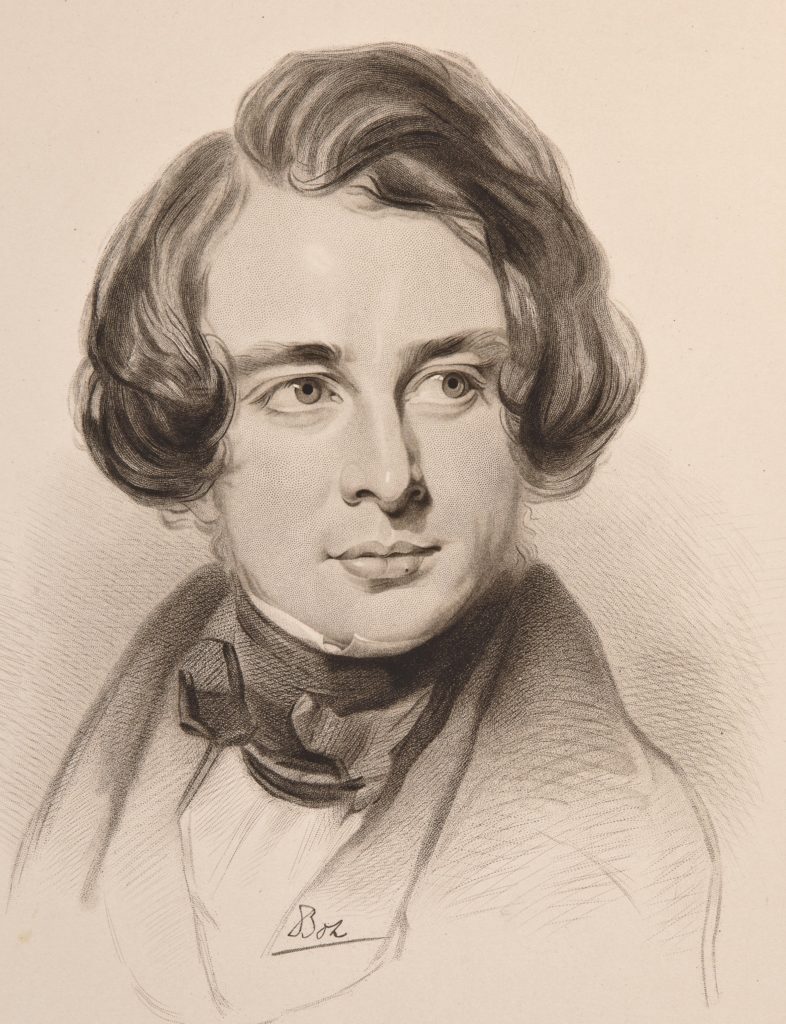
Charles Dickens c.1842
Dickens was a complex man. A husband and father, he was passionate about education for all and a steadfast campaigner for public libraries. Many visitors to Highclere think their favourite room in the Castle is the Library. Charles Dickens would probably be horrified to see how little we seem to value libraries today, at least in this country. In the old days, when I travelled to New York, I loved to visit the central Public Library and earlier this year I spent some days in the British Library in London: they promise such treasure. Researching the legacy of Bishop William of Wykeham who lived at Highclere between 1380 and 1402, what does he mention? His books -and what was his legacy? Schools and learning for the most disadvantaged. A legacy shared with Dickens and the philanthropists who helped fund Libraries such as the one in New York.
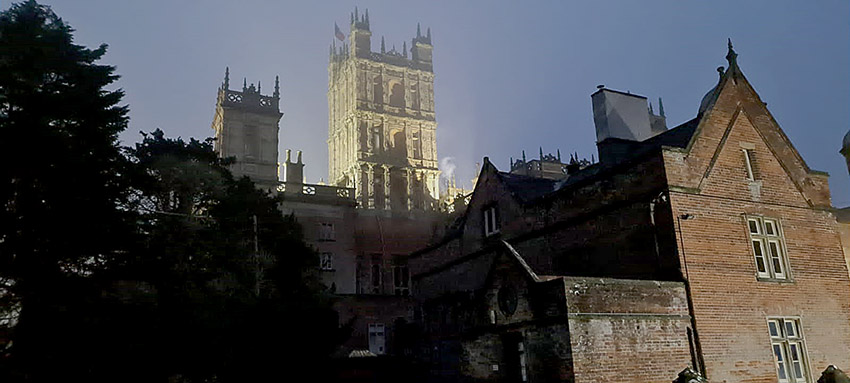
The spookier courtyard view of the Castle.
The plot of the Christmas Carol encouraged Dicken’s audience to become more aware of the struggle for survival that was the daily life of so many families at that time and therefore to become more charitable and less ignorant. We have all had a challenging year and past experiences help us to observe and analyse events and plan our way forward. In particular, it has perhaps magnified the gap between what we should value as opposed to the price we pay in any number of arenas and given us much food for thought.
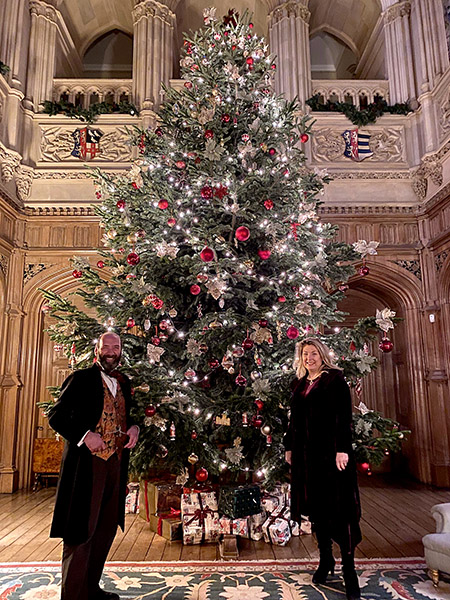 Last week, Gerald Dickens, the great great Grandson of Charles Dickens, kindly performed some excerpts from a Christmas Carol in the Castle which we filmed for our Instagram account @highclere_castle as we were sadly not permitted to have a live audience. However, there is an even better version on his website at https://www.geralddickens.com/films.html.
Last week, Gerald Dickens, the great great Grandson of Charles Dickens, kindly performed some excerpts from a Christmas Carol in the Castle which we filmed for our Instagram account @highclere_castle as we were sadly not permitted to have a live audience. However, there is an even better version on his website at https://www.geralddickens.com/films.html.
In addition, in what I hope is our own “Dickensian” spirit, our competition to help so many others is still running on the front of our website, along with the links to the relevant “just giving pages” and the chance of some truly wonderful prizes. We will be picking the winners on December 19th, on the date when the “A Christmas Carol” was first published. Please do share this with as many people as possible.

The final Stave of “A Christmas Carol” ends with “I will honour Christmas in my heart, and try to keep it all the year. I will live in the Past, the Present, and the Future. The Spirits of all three shall strove within me. I will not shut out the lessons that they teach”








 Instagram
Instagram
I was truly blessed to see Charles Dickens…the great great grandson…do The Christmas Carol at our St. Paul Hotel twice. He was wonderful and I brought a dear friend and my mother-in-law on a sub zero day in Minnesota. He came for many years and then decided…at that time…to take a break and be with his family. He was absolutely amazing.
Thank You Terri for Your delightful remembrance :~) Wish I could have attended one of these performances. Our local Saint Paul Hotel is also a treasure onto itself. Situated next to the “Landmark Center”, across from the “Ordway Theatre” and the Main Library, it’s a must visit place in Minnesota year ‘round !
I agree he is amazing!
This is so beautiful! Thank you for sharing this traditional Christmas story for these new times. Definitely something to reflect upon with a renewed perspective. ‘Happy Christmas’!
This was a wonderful reminder to open our hearts during the Christmas season especially this year. A Christmas Carol is one of my very favorite books. I read it every year at Christmas time and watch the old movie with Alastair Sims as Scrooge. Such a simple story written in beautiful prose that remains so relevant even today.
Thank you for sharing your thoughts and the beautiful pictures of Highclere Castle.
Dear Lady Carnarvon,
A humbling and timeless message that we should be reminded of often. Dickens captured the essence and spirit of his characters, and gives us pause to reflect upon our own character. Thank you for the beautiful Christmas message.
May you and your loved ones stay healthy and well.
Best regards,
Charlotte Merriam Cole
He was a great story teller
Lady Carnarvon,
Lessons learned then give wisdom now — a thought from great literature through the ages, from ancient scholars to Dickens and our present world in great need. Through the mists surrounding Highclere we can hope that the sparkling Christmas trees along the path remind us of those whose lives we can give a hand up. We pray that those who are without will benefit from our gifts. We can go to our nearest non-profit to find what those needs are.
Thank you for what you are doing in that regard.
May your holidays be filled with love, joy, justice and needed help for others.
Martha G
Great post! I wanted to thank you for the fun cocktail party you and your husband hosted on Friday. I had a great time lol! I loved seeing the pony and it was interesting to hear about Highclere gin and to watch your talented bartender mix up drinks. I hope the recipes will be forthcoming (especially the cocktail featuring elderflower). Looking forward to the next one on December 18! Best regards from NYC.
So glad you enjoyed the cocktail party on Friday night. Muffet had fun too!
My husband and I absolutely love going to our local library. It’s a beautiful old Victorian style home converted to our county’s main library, in the small town of Honesdale, PA.
We too, were able to see Gerald Dickens perform in person several times at the Byers Choice Factory in Chalfont, PA. Byers Choice makes the unique Christmas Carolers and many other figures. He is truly an amazing talented man! Have a wonderful and blessed Christmas season!
I wonder if Libraries could show his show – if not this year next year on screens?
Lady Carnarvon, I love Charles Dickens. I find it amazing that the great great Grandson of Charles Dickens, Gerald Dickens was with you at Highclere Castle. Incredible. Like Karen, I too watch the original movie with Alastair Sims. It is all part of my Christmas. Best Wishes To All, Cheryl
Thank you – what a storyteller!
As a retired librarian I was very pleased to read your message. I also feel that we need to help those less fortunate, especially this year when so many have lost their livelihoods. Thank you for all your do and for your wonderful messages; I look forward to them every Monday!
JoAnn (US)
Thank you
Greetings from Fort Worth, Texas. As a child, as a teenager, as an adult, and as a senior citizen, I consistently re-read Charles Dickens. At each stage of my life, there are parts of each story that I identify with more closely, bringing more insight to the characters and story lines. His books, therefore, will never be too dated. Just an insight I thought I would share.
Dear Lady Carnarvon,
the struggle for survival doesn’t get any easier, the struggles may change but the human element stays the same. Dicken’s captured this in a timeless story that resonates today. A bit of compassion, a friendly word, support and kindness can go a long way. Even with COVID, these qualities are making such a huge difference to every day life. Another thoughtful blog, thank you.
Jane
Thank you – yes there are usually thoughts unsaid…
Dear Lady Carnarvon,
It truly is not Christmas at our house without reading and viewing A Christmas Carol. Someday I hope to enjoy Gerald Dickens presentation in person as well.
Our oldest daughter gave me a memory book one Mother’s Day and in it she wrote one of her fondest childhood memories was getting her own library card. It warmed my heart that such a simple thing gave her such joy.
We are a family of readers. Our children, grandchildren and now our great grands.
Thank you for your interesting and entertaining blogs. Monday is my favorite weekday because of them.
Sincerely,
Theresa
His film is excellent and begins in graveyard… good viewing and actually a nice gift too
Gerald Dickens is Lady Carnarvon’s guest in her official podcast this week – you hear it here: https://apple.co/3lEkmgd
Please do all listen to him this week – Thursday tune in
How lovely the trees along the drive to the castle! Beautiful photos and bringing us the Christmas spirit from Highclere as we sit in lockdown. So enjoyed seeing Gerald Dickens on a video, and I agree that Charles Dickens novels really should be read aloud, family sitting on a winter’s day around a fireplace. And definitely my favorite and “warm feeling” space at Highclere Castle is the Library! thank you so much for this Monday blog.
Thank you Catherine
Dear Lady Carnarvon & Monday Family,
I hope you are all well and seasons greetings to everyone.
Lady Carnarvon, you are to be commended for your ongoing promotion and support of such worthy charities, such as those that are being featured on Highclere’s website and competition page. (I suggest that all fellow bloggers review those webpages,)
Albeit short in length (a novella, rather than a novel), “A Christmas Carol” is undoubtedly my favourite work by Charles Dickens. The redemption of Scrooge and his eventual philanthropy are uplifting. A most appropriate literary work to feature on your Blog at this time.
A number of quotes therefrom certainly seem to be extremely applicable:
(a) For this particular year:
“ While there is infection in disease and sorrow, there is nothing in the world so irresistibly contagious as laughter and good-humour.”
(b) At this time of year
“ For it is good to be children sometimes, and never better than at Christmas, when its mighty Founder was a child himself.”
And
(c) In accordance with the theme of both the novella and this week’s blog:
“ Mankind was my business. The common welfare was my business; charity, mercy, forbearance, and benevolence, were, all, my business. The dealings of my trade were but a drop of water in the comprehensive ocean of my business!‘”
As with Scrooge, we should all strive to honour those ideals and Christmas itself with all our hearts, and try to keep them all the year.
And so to conclude, as Tiny Tim said, “A Merry Christmas to us all; God bless us, every one!”
Regards,
Jeffery Sewell
Yes God Bless us all
We were able to attend a feast at The Williamsburg Inn in Williamsburg, VA, where Mr Dickens entertained us between courses with his one-man show of A Christmas Carol. It was a most excellent evening. We are still hoping to come to Highclere sometime next year when covid restrictions have eased so that we can come from the states and enjoy much of your glorious country.
I look forward to greeting you at Highclere next year
We look forward to seeing you!
Dear Lady Carnarvon,
Another beautifully written tale from Highclere and thank you for providing the link to the video. I plan on renting the movie while at one of our childrens’ home later in the month. I am looking forward to it and I like the spooky view of Highclere.
Best Wishes
What a treat for you at the Castle. I was able to see a performance of Gerald Dickens at Rogers Gardens in Newport Beach, CA a few years ago. It was magical. It was set outside in a tent very much like one would find back in the old victorian days. I felt like I was transported back in time.
p.s. So excited to recieve a delivery of Highclere Castle Gin expected this week. Cheers!
My best to you and your family. Merry Christmas and may we all experience Happiness in the New Year!
Merry Christmas to you and your family.
My mother visited us at Christmas time when we lived near St Paul Minnesota. The one special thing I wanted to do with her was to see Gerald Dickens perform at the St Paul Hotel, it was during a wonderful tea time experience, As he started the performance, he walked over to our table for two, looked at mom and said Marley was as dead as a…. She said nothing. As I’m whispering to her door nail mom, door nail, he was patiently waiting. Nothing. He finally said yes! as a door nail! Gerald Dickens performance is one of my favorite Christmas memories of my mother.
He is fun!
Dear Lady Carnarvon:
Thank you for your Monday blog and for sharing with your reading audience the “Christmas Carol” storyline.
I was able to watch Mr. Dickens’ performance on the Castle’s Instagram account last week. Really enjoyed the presentation.
For future reference, there is an annual Dickens’ Festival in Holly, Michigan. Just as the name implies, the event centers around the book and the English time period in which it was written. Please have a look at the event’s website.
Until next Monday, may you have a good week.
Perpetua Crawford
P.S. I will be sending you an email via theoffice@… address with the hope that someone on your staff will bring it to your attention.
So glad you enjoyed the performance.
I would love to meet Mr. Gerald Dickens, and know that my wife would love it even more. Her maiden name is Dickens, and she’s a direct descendent of Mr. Charles. He was indeed a complex man, but what a literary genius!
WOW – well I hope we will have a live audience here with us next year …
Dear Lady Carnarvon,
I have always loved the Christmas Carol and certainly enjoyed watching Gerald Dickens’ performance on Highclere’s instagram. I can only imagine how wonderful the performance is live and in person. He was wonderful.
I also had fun participating in the cocktail party the other evening. Muffet did an excellent job! Y’all made the experience so much fun. I plan on viewing again on the 18th. I have tried to purchase the Highclere gin on the website but have had trouble. I am going to try and call the number and see if I can purchase the gin here in NC.
Continue to enjoy the holidays,
Pam
Thank you so much – we have just got about got the online shop in the USA gong from http://www.highclerecastlespirits.com but please call and email them and I will bring their notice to this
I have always enjoyed “A Christmas Carol.” Like Scrooge, the third ghost story made me think about the changes that I need to make! I am curious…what type of tree is your Christmas tree? It is beautiful. Merry Christmas to all at Highclere.
Golly I am not sure – may be a Balsam Fir
How lovely a podcast and pictures! This tale is an annual tradition for me .Thank you once again for providing serene moments over Monday morning breakfast.
Gerald was amazing – and what an honour to listen to him
I look so forward to your blog. Merry Christmas to you and your family!
Thank you so much !
Thank you so much for this blog. Charles Dickens has long been my favorite author and you have rekindled my desire to reread some of his books. On a trip to your lovely country a couple of years ago I was excited to visit the Charles Dickens museum and experience his home much as it was when he lived there. In fact I have a bust of him(which I purchased there) on my desk as well as a pen(also from the museum), which I still use. My wife on the other hand is a long time fan of the Bard and needless to say our library contains most of if not all of the works of both men.
Thank you again. And I will definitely check out the link you mentioned.
Lin
It is rather special..
My dear Lady Carnatvon, I have never lived in a home that did not have a room called The Library. As a teacher for 37 years education has been my life. My daughter is now a college professor which makes me very proud, I Charles Dickens and his attitude of fostering education . I do enjoy your monthly visit from across the pond! Thank you for your dedication and love for your beautiful heritage.
Thank you for that lovely post. I learned to read, certainly under school age, by sitting on my Father’s knee and reading from a large print copy of A Christmas Carol. My Father’s Grandfather had conducted Penny Readings in Ashford, Kent and had known Mr Dickens. Literacy was thought then to be so important, sadly not so much now. My maternal Grandfather loved Dickens’ books and re read them all before he died. My mother did the same. I have handed on that same complete set of books to my daughter who also loves the stories. There was, in the family a portrait of Mr. Dickens , signed by him, but it has been lost now, along with the large print copy, in various moves, I wish we still had them.jose
Please keep telling your husband how lucky he is to have such a splendid wife!!!
I got to meet Gerald C. Dickens when he did his Christmas Carol performance in Riverside, CA, USA, a few years ago, just before the Dickens Festival there. My friends and I dressed in costume especially for it. I told him I had been waiting for years for him to return there to see it, and had him autograph my CD recording of his live play. Later at the end of his presentation, while he was “walking the streets”, he came to me, took my hand and kissed it, saying “Enchante, madam. That’s the only French I know.” I literally melted, and was as red as the red bustle dress I had on.
I am definitely going to watch his online presentation this month. –Val
He is very charming !!!
Thank you for sharing this traditional Christmas. Happy Christmas.
Happy Christmas to you too!
Hello Lady Carnarvon
A Christmas Carol reminds us how we should help those less fortunate than ourselves and the empathy we should have with their plight.
As Jeffrey Sewell quoted previously “mankind was our business etc”. A great eye opener of what are some of the important things in our lives, always to be remembered, acted upon every day and of course laughter must be included.
I introduced my grand-daughter Leith to the classics starting with Pride and Prejudice (both the book and CD of the British Series), then her natural curiosity took over. Her original book has been read and re-read and now has the interest of her daughter who told me a few weeks ago about this “great classic book” her mother had given her and how much she loved it !! I was happy to hear that and I will buy her A Christmas Carol as a gift.
We have all had a dreadful year but thankfully Australia has turned the corner and we have had several weeks of no Covid virus cases in my State. We are alert that we still should practice the strict regime our Government put in place and be aware it could break out again if we become complacent. I pray 2021 will give us a happier world than we had this year.
I shall also say “A Merry Christmas one and all”..
Joy Roebig
Thank you for reminding us that even though the past year has been so bleak that we should stop worrying and just immense ourselves in the Christmas spirit. Then revisit all the old traditions that can warm our hearts.
Dear Lady Carnarvon,
Thank you for giving life to a Christmas Carol this holiday season via Gerald Dickens, the great great Grandson of Charles Dickens.
In late October, this author published a modern day version of Dickens’ classic called Ghosts of Presidents Past-A Reckoning. A work of historical fiction, the new book imagines what past commanders-in-chief would tell an incumbent much like the current one. Beginning with George Washington, twenty-three distinguished presidents appear over the course of several evenings. Each shares relevant successes and regrets from his administration (the past) and departs with warnings for the incumbent (the present). Throughout the novel, a fictitious network news broadcaster (Ferret News) provides a glimpse of the future and the unintended consequences of the incumbent’s follies.
The day of the final debate between President Trump and Vice President Biden, Newsweek Magazine published an interview with the author. Ghosts of Presidents Past-A Reckoning ends with a brighter 2021 for the nation and the world. Did the Ghosts reform the incumbent? Not telling. You will have to read the story. James Mikel Wilson, a Proud Supporter of Houston Public Media-PBS-NPR
As a retired librarian, I thank you for your beautiful and poignant observations about public libraries. They are a mainstay of democracy and a beacon of lifelong learning. We all should treasure them and take advantage of the many resources they make available to everyone.
They do matter.
MY DEAR LADY CARNARVON,
SNOW IN HIGHCLERE.WONDERFUL VIDEO IN INSTAGRAM. THANK YOU VERY MUCH MILADY I LOVE THE FOG, SNOW DAYS AND FOG.
VILA ALEMÃ
RIO CLARO – SP
BRAZIL
Thank you!
Good day Countess,
So tell us why you can’t have a live audience at the castle when someone is performing, such as Mr. Dickens? I’d be curious to know the why?
In the UK, at the moment, we are living with various Covid guidelines
One of my absolute all-time favorites!! I read it every year about this time. How wonderful it would be to see him perform parts of this! I just watched the George C. Scott version this afternoon. I agree about the importance of libraries. My mother was a librarian, so they hold a very special place in my heart. There is nothing like spending time in one…from the peacefulness to the smell of the books themselves.
Merry Christmas
Lisa
Merry Christmas to you
Dear Lady Carnarvon,
Thank you for an uplifting Christmas read! I love the library at Highclere. When we visited, it looked so inviting and warm with the fireplace, a room that invites a person to read by the fire on a cold winter day. I would rather read a book with covers than on a tablet or laptop. Flipping the pages and holding onto the book adds a warm feeling as I progress through the story. Reading “A Christmas Carol” orally from a book at Christmas is a great tradition! Love your pictures, too!
Merry Christmas (Mele Kalikimaka) to your family and staff!
Ada
Thank you so much
Lady Carnarvon, your video today of Highclere Castle and grounds is just beautiful. It is so peaceful looking. Did anything come in the post for you! Always a worry for me considering the past. With My Very Best Wishes, Cheryl
Not yet – Cheryl I think braces of Covid the post is busy both incoming and dispatching !!
Lady Carnarvon, I wish for you continued success for the month of December. I can only think it is a busy one for you and your staff. Wish I was there! With Kind Regards, Cheryl
Thank you so much – we are busy and fortunate to be open
MY DEAR LADY CARNARVON,
IT’S A RAINY DAY. 26 °CELSIUS.
THANK YOU SO MUCH MILADY FOR YOUR BEAUTIFULS WORDS FROM CHARLES DICKENS .
I AM A TEACHER OF BRAZILIAN,PORTUGUESE AND FRENCH LANGUAGES AND LITERATURES BUT I READ AND WRITE A LITTLE IN ENGLISH.I READ CHARLES DICKENS IN PORTUGUESE WICH ALREADY LOSE MUCH OF THE ORIGINALS AND I HAVE ALWAYS ADMIRED THE SISTERS BRONTË, JANE AUSTEN AND OF COURSE CHARLES DICKENS.
MERRY AND HAPPY A GLORIOSUS CHRISTMAS WHITE AND A WONDERFUL NEW YEAR FOR MILADY AND MILORDY AND ALL YOUR STAFF AND A MONDAY FAMILY.
GOD BLESS THE WORLD.
VILA ALEMÃ
RIO CLARO – SP
BRAZIL
Happy reading – nothing better
Libraries have a special place in my life. When on summer break, Mama and I would make our way to the public library that is a grand edifice built with funds from Andrew Carnegie and was completed in 1916. My memories of the children’s section are of a beautiful fairy tale mural painted on the walls. Mama would leave me, safely (who would do that in these times?), in the children’s section to make my selections while she went to the adult library. I read the Black Stallion books, Black Beauty, Nancy Drew (that eventually led to my love of British mysteries), and the list goes on. Every two weeks, we would make our way to the library to return the due books and check out more books. I thought I had arrived when I was allowed to start checking out books from the adult section and the one book I remember distinctly is Celia Garth. Eventually, I read A Christmas Carol for English literature in high school. The first film version I saw was Albert Finney’s Scrooge. My personal favorite portrayal is that of George C. Scott, filmed in Shrewsbury. I had the good fortune, 33 years ago, to visit Shrewsbury and stayed in the same inn Scott did while filming. How wonderful it would be to hear A Christmas Carol read, as Dickens performed it so many years ago, by his great great grandson! Technology has been a blessing during these strange times in so many ways but has also put a hurting on traditional books. There is nothing like holding a book in your hands and turning a page. Many blessings to you and yours this holiday season!
Happy Christmas to you and your family!
Lady Carnarvon,
You always have some interesting people in your mist. And Highclare has a lot of spectacular views.
Have a Merry Christmas and and a blessed New Year!
Phyllis Simpson, USA
Thank you
I know this is off topic.
I was tremendously excited that Tanger Outlets here on New York Long Island was able to display some of the wardrobe from Downtown Abby . As we could not travel to Biltmore Estate as we had hoped due to Covid. Funny enough some pieces looked like they where straight out of my Grandmother closet !
I can see how wonderful it must have been to watch it being made .
I just want to say thank you for opening you home to film such a wonder series.
Now back to Christmas .
Dina
How lovely – a moment to think about something else!!
Ever since I can remember I have been a fan of the writings of Mr. Charles Dickens. I recall seeing The Christmas Carol movie, starring Sir Albert Finney, with my parents when I was a young girl. The manner in which that story was told captivated me then and now. I went on to love and admire other works of Mr. Dickens, especially Little Dorrit. My husband and I spent several weeks in England and Scotland and we made a point of visiting Mr. Dickens’ home for the day. It was amazing to see his writing desk and think of all he created there. Thank you for this post, Lady Carnarvon. It’s my new favorite!
Happy Christmas to you and yours!
Hope it is a healthy 2021 for you!
Thank you and happy Christmas to you!
What an enjoyable and instructive article, Lady Carnarvon. My best wishes for you
and your family to have a safe and happy Christmas season and a forthcoming New Year
that is also safe and fructiferous. Please keep on with your informative and delightful endeavors.
Amazing read! Your thoughts on [topic] have really enlightened me in ways I hadn’t anticipated. I’ve been tracking discussions on this topic for a while, but your perspective is distinctly insightful. The way you’ve woven facts with practical insights is utterly impressive. Your narrative abilities are outstanding, and the examples you gave were both enlightening and captivating. It’s rare to find a piece that educates but also delights, and you’ve done exactly that! I’m particularly interested by your point about the idea you presented. It’s given me a lot to think about and has fueled a curiosity I’m keen to explore further. Continue the great work! I can’t wait to see what topic you explore next. Your blog is a treasure trove of insights.